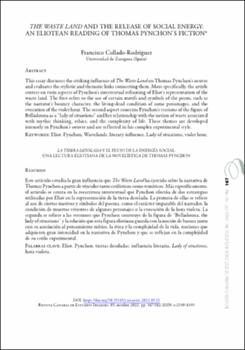The Waste Land and the Release of Social Energy: An Eliotean Reading of Thomas Pynchon’s Fiction
Fecha
2022Resumen
Este artículo estudia la gran influencia que The Waste Land ha ejercido sobre la narrativa de
Thomas Pynchon a partir de vínculos tanto estilísticos como temáticos. Más específicamente,
el artículo se centra en la reescritura intertextual que Pynchon efectúa de dos estrategias
utilizadas por Eliot en la representación de la tierra desolada. La primera de ellas se refiere
al uso de ciertos motivos y símbolos del poema, como el carácter imparable del narrador, la
condición de muertos vivientes de algunos personajes o la evocación de la hora violeta. La
segunda se refiere a las versiones que Pynchon construye de la figura de “Belladonna, the
lady of situations” y la relación que esta figura eliotiana guarda con la noción de basura junto
con su asociación al pensamiento mítico, la ética y la complejidad de la vida, nociones que
adquieren gran intensidad en la narrativa de Pynchon y que se reflejan en la complejidad
de su estilo experimental. This essay discusses the striking influence of The Waste Land on Thomas Pynchon’s oeuvre
and evaluates the stylistic and thematic links connecting them. More specifically, the article
centers on twin aspects of Pynchon’s intertextual reframing of Eliot’s representation of the
waste land. The first refers to the use of certain motifs and symbols of the poem, such as
the narrator’s bouncy character, the living-dead condition of some personages, and the
evocation of the violet hour. The second aspect concerns Pynchon’s versions of the figure of
Belladonna as a “lady of situations” and her relationship with the notion of waste associated
with mythic thinking, ethics, and the complexity of life. These themes are developed
intensely in Pynchon’s oeuvre and are reflected in his complex experimental style.





